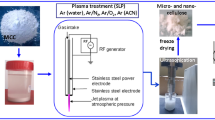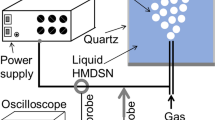Abstract
Plasma-liquid interactions constitute a highly active research field in terms of both fundamentals and applications. In this study, we investigate the interactions between pulsed nanosecond discharges generated in air in contact with a suspension of crystalline nanocellulose (CNC). The evolution of discharge characteristics as a function of plasma processing time is analyzed using current-voltage characteristics, optical imaging, and optical emission spectroscopy. After a certain treatment time, the discharge transits from streamer to spark-like emission. The transition moment depends on both, voltage magnitude and polarity. Furthermore, Fourier transform infrared spectroscopy reveals that plasma processing modifies the contents of amorphous and crystalline structures in CNC. Such modification is also dependent on voltage magnitude and polarity, as well as on the plasma treatment time.











Similar content being viewed by others
Data Availability
All data generated or analysed during this study are included in this published article.
References
Bruggeman PJ et al (2016) Plasma–liquid interactions: a review and roadmap. Plasma Sources Sci Technol 25(5):053002
Rezaei F et al (2019) Applications of plasma-liquid systems: a review. Materials 12(17):2751
Adamovich I et al (2022) The 2022 plasma Roadmap: low temperature plasma science and technology. J Phys D 55(37):373001
Kovačević VV et al (2022) Low-temperature plasmas in contact with liquids—a review of recent progress and challenges. J Phys D 55(47):473002
Belmonte T et al (2014) Interaction of discharges with electrode surfaces in dielectric liquids: application to nanoparticle synthesis. J Phys D 47(22):224016
Chen Q, Li J, Li Y (2015) A review of plasma–liquid interactions for nanomaterial synthesis. J Phys D 48(42):424005
Chiang WH et al (2020) Microplasmas for advanced Mmterials and devices. Adv Mater 32(18):e1905508
Guo D et al (2021) Plasma-activated water production and its application in agriculture. J Sci Food Agric 101(12):4891–4899
Zhou R et al (2020) Plasma-activated water: generation, origin of reactive species and biological applications. J Phys D 53:303001
Bourbeau N, Soussan L, Hamdan A (2022) Degradation of methylene blue by pulsed nanosecond discharge in Ar, O2, and N2 gaseous bubbles in water: evaluation of direct and postprocessing modes. J Vacuum Sci Technol 40(5):053003
Ruamrungsri S et al (2023) Effects of using plasma-activated water as a nitrate source on the growth and nutritional quality of hydroponically grown green oak lettuces. Horticulturae 9(2):248
Wu S et al (2021) Nitrate and nitrite fertilizer production from air and water by continuous flow liquid-phase plasma discharge. J Environ Chem Eng 9(2):104761
Dunleavy CS et al (2009) Characterisation of discharge events during plasma electrolytic oxidation. Surf Coat Technol 203(22):3410–3419
Yerokhin AL et al (2003) Discharge characterization in plasma electrolytic oxidation of aluminium. J Phys D 36(17):2110
Nguyen TS et al (2022) Cr(VI) reduction by microsecond pin-to-pin discharges generated in an aqueous solution. Plasma Chem Plasma Process 42(6):1279–1290
Mohammadi K, Hamdan A (2021) Spark discharges in liquid heptane in contact with silver nitrate solution: investigation of the synthesized particles. Plasma Processes Polym 18(10):2100083
Velusamy T et al (2017) Ultra-small CuO nanoparticles with tailored energy-band diagram synthesized by a hybrid plasma-liquid process. Plasma Processes Polym 14(7):1600224
Fauchais P et al (2013) Suspension and solution plasma spraying. J Phys D 46(22):224015
Fauchais P et al (2015) Key challenges and opportunities in suspension and solution plasma spraying. Plasma Chem Plasma Process 35(3):511–525
Ohad I, Mejzler D (1965) On the ultrastructure of cellulose microfibrils. J Polym Sci Part A: Gen Papers 3(1):399–406
Domingues RMA, Gomes ME, Reis RL (2014) The potential of cellulose nanocrystals in tissue engineering strategies. Biomacromolecules 15(7):2327–2346
Eichhorn SJ et al (2010) Review: current international research into cellulose nanofibres and nanocomposites. J Mater Sci 45(1):1–33
Jose CC, Lovely M, Sabu TK (2014) Review of recent research in nano cellulose preparation from different lignocellulosic fibers.
Siró I, Plackett D (2010) Microfibrillated cellulose and new nanocomposite materials: a review. Cellulose 17(3):459–494
Bakri MK, Rahman M (2021) Applications of cellulose materials and their composites. pp 267–284
Habibi Y, Lucia LA, Rojas OJ (2010) Cellulose nanocrystals: chemistry, self-assembly, and applications. Chem Rev 110(6):3479–3500
Peng BL et al (2011) Chemistry and applications of nanocrystalline cellulose and its derivatives: a nanotechnology perspective. Can J Chem Eng 89(5):1191–1206
Miao C, Hamad WYJC (2013) Cellulose reinforced polymer composites and nanocomposites: a critical review. Cellulose 20:2221–2262
Islam MT, Alam MM, Zoccola M (2013) Review on modification of nanocellulose for application in composites. Int J Innovative Res Sci Eng Technol 2:5444–5451
Mariano M, Kissi NE, Dufresne A (2014) Cellulose nanocrystals and related nanocomposites: review of some properties and challenges. J Polym Sci Part B: Polym Phys 52(12):791–806
Fujisawa S et al (2013) Surface engineering of ultrafine cellulose nanofibrils toward polymer nanocomposite materials. Biomacromolecules 14(5):1541–1546
Jonoobi M et al (2012) A comparison of modified and unmodified cellulose nanofiber reinforced polylactic acid (PLA) prepared by twin screw extrusion. J Polym Environ 20(4):991–997
Lee K-Y, Blaker JJ, Bismarck A (2009) Surface functionalisation of bacterial cellulose as the route to produce green polylactide nanocomposites with improved properties. Compos Sci Technol 69(15):2724–2733
Pei A, Zhou Q, Berglund LA (2010) Functionalized cellulose nanocrystals as biobased nucleation agents in poly(l-lactide) (PLLA) – crystallization and mechanical property effects. Compos Sci Technol 70(5):815–821
Robles E et al (2015) Surface-modified nano-cellulose as reinforcement in poly(lactic acid) to conform new composites. Ind Crops Prod 71:44–53
Babaei S et al (2023) Permeation properties of a plasma-processed organosilicon-carboxymethylcellulose bilayer on fibrillated cellulosic films for sustainable packaging applications Cellulose, submitted
Meunier L-F et al (2021) Modification of microfibrillated cellulosic foams in a dielectric barrier discharge at atmospheric pressure. Plasma Processes Polym 18(2):2000158
Alanis A et al (2019) Plasma surface-modification of cellulose nanocrystals: a green alternative towards mechanical reinforcement of ABS. RSC Adv 9(30):17417–17424
Matouk Z et al (2020) Functionalization of cellulose nanocrystal films using non-thermal atmospheric –pressure plasmas. Appl Surf Sci 511:145566
Hamdan A, Diamond J, Stafford L (2020) Time-resolved imaging of pulsed positive nanosecond discharge on water surface: plasma dots guided by water surface. Plasma Sources Sci Technol 29(11):115017
Herrmann A, Margot J, Hamdan A (2022) Influence of voltage and gap distance on the dynamics of the ionization front, plasma dots, produced by nanosecond pulsed discharges at water surface. Plasma Sources Sci Technol 31(4):045006
Gigosos MA, González M, Cardeñoso Vn (2003) Computer simulated Balmer-alpha, -beta and -gamma Stark line profiles for non-equilibrium plasmas diagnostics. Spectrochimica Acta Part B: Atomic Spectroscopy 58(8):1489–1504
Hamdan A, Diamond J, Herrmann A (2021) Dynamics of a pulsed negative nanosecond discharge on water surface and comparison with the positive discharge. J Phys Commun 5(3):035005
Hamdan A, Ridani DA, Diamond J, Daghrir R (2020) Pulsed nanosecond air discharge in contact with water: influence of voltage polarity, amplitude, pulse width, and gap distance. J Phys D 53(35):355202
Van der Horst RM et al (2012) Time-resolved optical emission spectroscopy of nanosecond pulsed discharges in atmospheric-pressure N2 and N2/H2O mixtures. J Phys D 45(34):345201
Lo A et al (2017) Streamer-to-spark transition initiated by a nanosecond overvoltage pulsed discharge in air. Plasma Sources Sci Technol 26(4):045012
Janda M, Machala Z, Niklová A, Martišovitš V (2012) The streamer-to-spark transition in a transient spark: a dc-driven nanosecond-pulsed discharge in atmospheric air. Plasma Sources Sci Technol 21(4):045006
Lo A, Cessou A, Boubert P, Vervisch P (2014) Space and time analysis of the nanosecond scale discharges in atmospheric pressure air: I. Gas temperature and vibrational distribution function of N2 and O2. J Phys D 47(11):115201
Lo A, Cessou A, Vervisch P (2014) Space and time analysis of the nanosecond scale discharges in atmospheric pressure air: II. Energy transfers during the post-discharge. J Phys D 47(11):115202
Lo A, Cléon G, Vervisch P, Cessou A (2012) Spontaneous Raman scattering: a useful tool for investigating the afterglow of nanosecond scale discharges in air. Appl Phys B 107:229–242
Lowke JJ (2013) Plasma predictions: past, present and future. Plasma Sources Sci Technol 22(2):023002
Popov NA (2003) Formation and development of a leader channel in air. Plasma Phys Rep 29:695–708
Bruggeman P, Liu J, Degroote J, Kong MG, Vierendeels J, Leys C (2008) Dc excited glow discharges in atmospheric pressure air in pin-to-water electrode systems. J Phys D 41(21):215201
Poletto M, Ornaghi HL, Zattera AJ (2014) Native cellulose: structure, characterization and thermal properties. Mater (Basel) 7(9):6105–6119
Hamdan A et al (2020) Pulsed nanosecond air discharge in contact with water: influence of voltage polarity, amplitude, pulse width, and gap distance. J Phys D 53(35):355202
Julák J et al (2018) Contribution to the chemistry of plasma-activated water. Plasma Phys Rep 44(1):125–136
Machala Z et al (2019) Chemical and antibacterial effects of plasma activated water: correlation with gaseous and aqueous reactive oxygen and nitrogen species, plasma sources and air flow conditions. J Phys D 52(3):034002
Funding
This work was financially supported by the National Science and Engineering Research Council (NSERC), PRIMA-Québec, Plasmionique Inc., and FPInnovations. Research infrastructures were funded by the Canadian Foundation for Innovation.
Author information
Authors and Affiliations
Contributions
AH wrote the main manuscript text and prepared the Figures. TCL did the experiments under the supervision of AH and LS. JP contributed to the experimental design. MER and LS contributed to the writing and revision of the manuscript. All authors reviewed the manuscript.
Corresponding author
Ethics declarations
Conflict of interest
The authors declare no competing interests.
Ethical Approval
Not applicable.
Additional information
Publisher’s Note
Springer Nature remains neutral with regard to jurisdictional claims in published maps and institutional affiliations.
Rights and permissions
Springer Nature or its licensor (e.g. a society or other partner) holds exclusive rights to this article under a publishing agreement with the author(s) or other rightsholder(s); author self-archiving of the accepted manuscript version of this article is solely governed by the terms of such publishing agreement and applicable law.
About this article
Cite this article
Hamdan, A., Liu, T.C., Profili, J. et al. Interaction of a Pulsed Nanosecond Discharge in Air in Contact with a Suspension of Crystalline Nanocellulose (CNC). Plasma Chem Plasma Process 43, 849–865 (2023). https://doi.org/10.1007/s11090-023-10335-w
Received:
Accepted:
Published:
Issue Date:
DOI: https://doi.org/10.1007/s11090-023-10335-w




